ASIC Miner ICERIVER KAS KS0 Profitability In the realm of cryptocurrency mining, the Iceriver KAS KS0 miner has garnered widespread attention. Tailored specifically for the Kaspa network's KHeavyHash algorithm, it boasts high hashing power and low power consumption, making it an ideal choice for many miners. In this article, we will comprehensively assess IceRiver KS0 profitability while considering the Kaspa market conditions and the attributes of KS0 miner. Kaspa Market Dynamics Kaspa is a vibrant cryptocurrency network aimed at delivering high performance and scalability for everyday transactions. At the time of writing this article, the Kaspa coin trades at approximately $0.04959. But it's essential to note that cryptocurrency markets are highly susceptible to price volatility. Hence, investors must remain vigilant about market dynamics. Additionally, the Kaspa network's mining difficulty and reward mechanisms play a role in mining returns. Attributes of the IceRiver KS...
Antminer S19 Pro and Whatsminer M30S+ performance comparison
Today, we compared and measured various performance metrics of the latest and most energy-efficient bitcoin mining products, MicroBT’s Whatsminer M30S+ and Bitmain’s Antminer S19 Pro. The more expensive 7nm Bitmain products are more powerful, but the miners are very similar in output. The data shows that Bitmain miners are slightly better than Whatsminer, but Whatsminer seems to have higher stability.
Overview
In this article, we will experiment with both products, running each miner for some time and recording various performance metrics such as hash rate, power consumption, temperature, sound level, and even the airflow speed of the main outlet.
It should be noted that the Whatsminer M30S+ is not the most advanced product of MicroBT.
Miner | Official hash rate (TH/s) | Efficiency (J/TH) |
Antminer S19 | 95 | 34.5 |
Antminer S19 Pro | 110 | 29.5 |
Whatsminer M30S+ | 100 | 34.0 |
Whatsminer M30S++ | 112 | 31.0 |
Hash rate
The S19 Pro reportedly has a hash rate of 110 TH/s, while the Whatsminer M30S+ can reportedly generate 100 TH/s. After the firmware was upgraded to the latest version, the Whatsminer M30S+ achieved an average hash rate of 103.8 TH/s, 3.8% higher than the official website, while the Bitmain S19 Pro reached 110.7 TH/s, 0.6% higher than the fixed network. The graph also shows that Whatsminer miners have achieved a more stable hash rate with significantly less variance than Bitmain products over the same period. We believe this stability is an essential factor in supporting MicroBT.
Differences in hash rate may also be driven by different test environments, such as temperature, etc., which may affect the results.
The graph below shows each miner’s hash rate as reported by the pool, based on 15 minutes of running data, and therefore has a higher variance.
Hashrate reported by Whatsminer M30S+ pool (TH/s)
Antminer S19 Pro mining pool reported hash rate (TH/s)
Energy efficiency
Both products performed well in terms of energy efficiency, in line with official figures. Whatsminer used an average of 34.4 J/TH during this period, which is 1.0% higher than the official website's 34 J/TH. Antminer performed slightly better, with an average usage rate of 29.7 J/TH, 0.6% faster than the official website.
Whatsminer M30S+ mining efficiency (J/TH)
Antminer S19 Pro mining efficiency (J/TH)
Whatsminer high power mode
The Whatsminer M30S+ also has a "High Power" mode option that averages 109.4 TH/s during miner operation, a significant improvement over the "Normal Power" mode. Of course, this also consumes more power, 3,743 W compared to 3,331 W under normal conditions.
Hashrate (TH/s) reported by Whatsminer M30S+ Pool – high power mode
In high power mode, the Whatsminer is slightly more energy efficient, with an average efficiency of 34.3 J/TH.
Whatsminer M30S+ mining efficiency (J/TH) – high power mode
Temperature
One of the most notable differences between devices in Bitmain's favor is the average temperature of the miners. We measured the temperature every hour, placing an electronic thermometer 15cm from the main air outlet, and the Antminer averaged 45.9°C, about 10.5°C lower than the Whatsminer. This could be due to the Antminer's lower power consumption or the Antminer's excellent cooling, which has more fans and produces higher airflow speeds.
Miner temperature (°C)
(Note: The temperature measurement is 15cm away from the miner, directly in the airflow outside the main exhaust port)
Sound
We measured the noise level produced by each machine by placing a sound level meter 15 cm from the miner in a direction perpendicular to the main airflow. The Whatsminer produced an average sound of 83.0 dB, while the Antminer was 81.4 dB.
Miner volume (dB)
(Note: The sound level meter is placed 15 cm away from the miner, perpendicular to the fan outlet)
(Measures the sound level produced by Whatsminer M30S+)
Airspeed
Based on an average of 10 readings, one hour apart, the Antminer averaged 5.2 m/s while the Whatsminer averaged 3.0 m/s.
Miner airflow speed (m/s)
(Note: The wind speed is measured at a distance of 15cm from the miner, directly in the airflow outside the main exhaust port.
(Measures the air velocity produced by the Whatsminer M30S+)
Start time
One key area where we found Antminer to be stronger is startup time. Based on an average of five attempts, Antminer reaches its target hashrate in about 4 minutes, while Whatsminer takes an average of about 27 minutes to start. However, this may be due to a security feature in Whatsminer.
Time (minutes) for miners to reach their target hash rate
(Note: Average of five attempts)
In conclusion
The first thing to note is that the Antminer S19 Pro is a better and more energy-efficient machine, at 29.7 J/TH, much lower than Whatsminer's 34.4 J/TH. However, MicroBT has introduced a newer product, the M30S++, which is now on sale, with a reported efficiency of 31.0 J/TH. As for the product itself, based on the data in this report, we can conclude that the two companies are neck and neck, and everyone can choose the miner brand that suits them according to their preferences.
The content of this article and pictures are from the Internet, compiled and edited by ZEUS MINING. If there is any infringement, please get in touch with us to delete it.
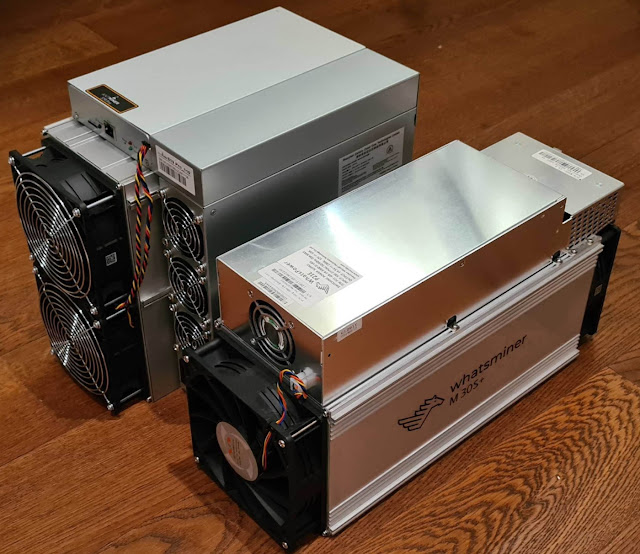
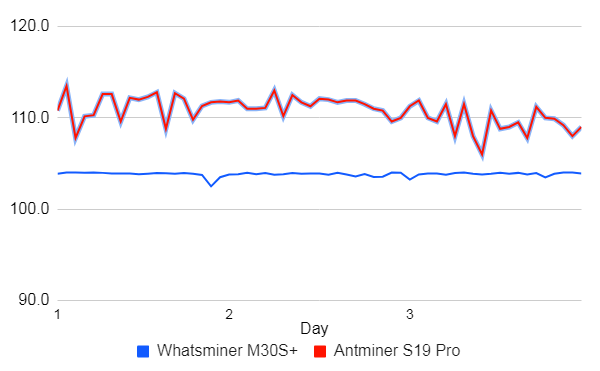



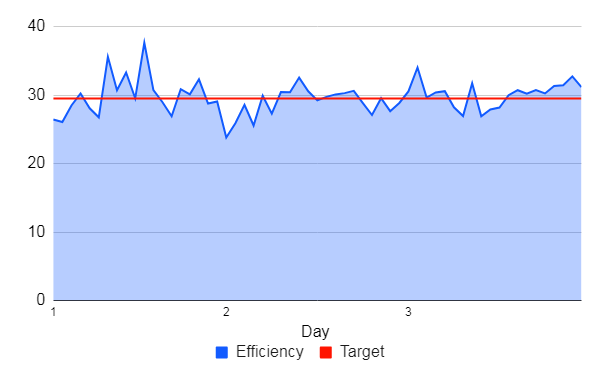
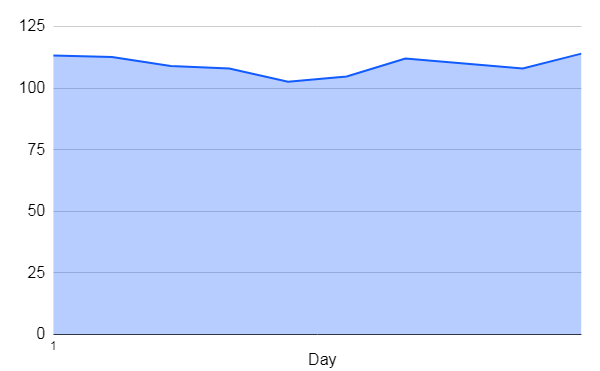
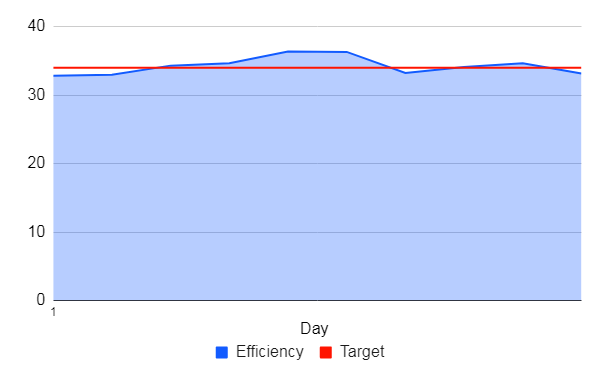

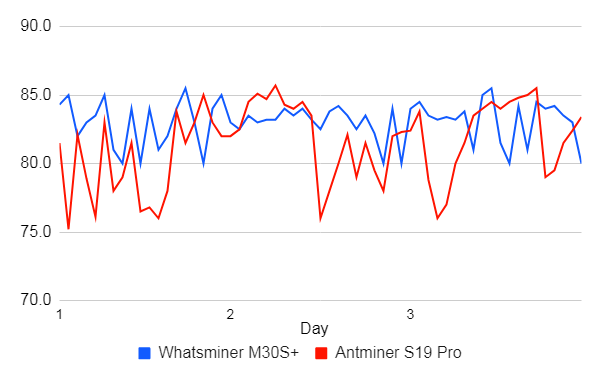
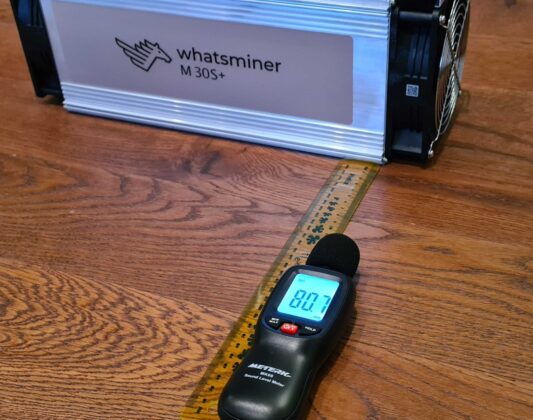


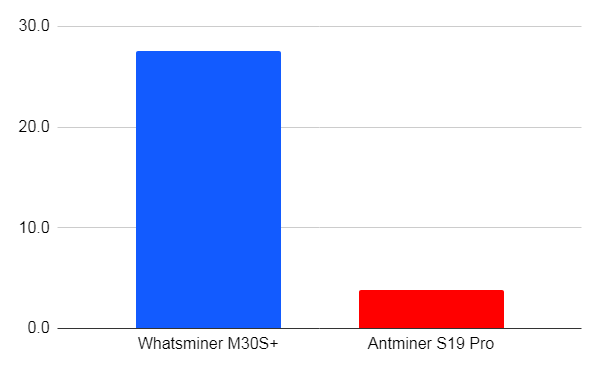
Comments
Post a Comment
Tell us your opinion